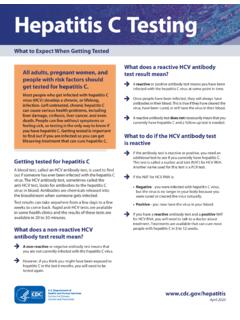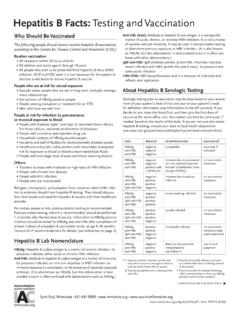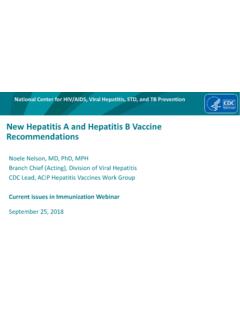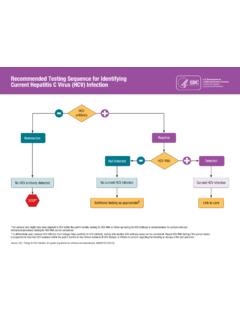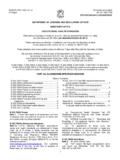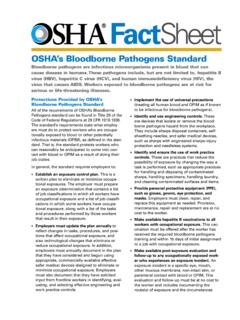Transcription of Health clearance for tuberculosis, hepatitis B, hepatitis ...
1 Health clearance for tuberculosis , hepatitis B, hepatitis C and HIV:New healthcare workersHealth clearance for tuberculosis , hepatitis B, hepatitis C and HIV:New healthcare workersREADER INFORMATIONP olicyEstatesHR/WorkforcePerformanceManag ementIM & TPlanningFinanceClinicalPartnership WorkingDocument purposeBest Practice GuidanceGateway reference5514 TitleHealth clearance for tuberculosis , hepatitis B, hepatitis C and HIV: New healthcare workersAuthorDepartment of Health / Health ProtectionDivision/General Health ProtectionPublication dateMarch 2007 Target audiencePCT CEs, NHS trust CEs, SHA CEs, medicaldirectors, directors of public Health , directors ofnursing, PCT PEC chairs, directors of HR, alliedhealth professionals, occupational physicians andnurses, consultants in communicable diseasecontrol and consultant microbiologists andvirologists.
2 For information only for foundationtrust CEsDescriptionThis guidance provides advice on Health clearanceof new healthcare workers for tuberculosis , hepatitis B, hepatitis C and HIVC ross referenceHealth clearance for serious communicablediseases: New healthcare workers draftguidance for consultation (January 2003)Superseded documentsN/AAction requiredIt is recommended that the Health clearancemeasures for new healthcare workers set out inthe guidance are implemented as soon as isreasonably practicableTimingN/AContact detailsGerry RobbGeneral Health ProtectionDepartment of HealthWellington House133 155 Waterloo RoadLondon SE1 8UG020 7972 recipient useSummary1 Introduction2 Rationale5 Summary of action6 Existing Health checks7 Categories of new healthcare worker8 Students8 Medical students8 Nursing students9 Dental, midwifery, paramedic.
3 Ambulance technician andpodiatric surgery students9 Healthcare workers who are performing EPPs for the first time9 Healthcare workers who are returning to the NHS and who may have been exposed to serious communicable diseases10 Healthcare workers from locum and recruitment agencies, including NHS Professionals10 Healthcare workers in the independent healthcare sector11 Standard Health checks for healthcare workers who are new to the NHS12TB12 Preventing infection in healthcare settings: occupational health14 hepatitis B immunisation15 Offer of testing for hepatitis C: non-EPP workers16 Offer of testing for HIV: non-EPP workers17 ContentsAdditional Health checks for hepatitis B, hepatitis C and HIV for EPP healthcare workers who are new to the NHS and who willperform EPPs.
4 And for existing workers who are new to EPPs18 hepatitis B18 hepatitis C20 HIV21 Other considerations22 Overseas recruitment22 Laboratory tests23 Identification and validation of samples submitted for testing23 Laboratories24 Health clearance certificates24 Healthcare workers who are applying for posts or training involving EPPs and who decline to be tested25 Occupational Health advice25 Confidentiality26 Publicising the new arrangements to prospective employees and students27 Audit and surveillance27 Annex AExtract from Immunisation against infectious disease28 Annex BExposure-prone procedures (EPPs)39 Annex CRegulatory bodies statements on professional responsibilities53ivHealth clearance for tuberculosis , hepatitis B, hepatitis C and HIV: New healthcare workersThis guidance recommends that all new healthcare workers have checks fortuberculosis disease/immunity and are offered hepatitis B immunisation, with post-immunisation testing of response and the offer of tests for hepatitis C and standard Health clearancechecks should be completed on new healthcare workers who will perform exposure-prone procedures (EPPs),additional Health clearanceshould also be undertaken.
5 Additional Health clearancemeans being non-infectious for HIV (antibody negative), hepatitis B (surfaceantigen negative or, if positive, e-antigen negative with a viral load of 103genomeequivalents/ml or less) and hepatitis C (antibody negative or, if positive, negativefor hepatitis C RNA). These checks should be completed before confirmation of anappointment to an EPP post, as the healthcare worker will be ineligible if foundto be the purposes of this guidance, a new healthcare worker includes healthcareworkers new to the NHS, healthcare workers moving to a post or training thatinvolves EPPs and returning healthcare workers, depending on what activities theyhave engaged in while away from the Health service (see paragraphs 21 23).
6 This guidance is intended not to prevent those infected with blood-borne virusesfrom working in the NHS, but rather to restrict them from working in those clinicalareas where their infection may pose a risk to patients in their care. This is consistentwith existing policy, which imposes restrictions on the working practices of thosehealthcare workers who are known to be infectious carriers of HIV, hepatitis B andhepatitis is recommended that the measures proposed in this guidance are implemented assoon as is reasonably 2001, Ministers set up an expert group to carry out an assessment of thepotential Health risk posed to patients by healthcare workers who are newto the NHS and who are infected with tuberculosis (TB), hepatitis B, hepatitis C or HIV.
7 This decision was prompted by the convergence ofthree issues: the recruitment of staff to the NHS from overseas who weresubsequently found to be infected with blood-borne viruses (BBVs); individuals infected with BBVs who were seeking to enter medical,dental, midwifery and nursing schools and to qualify and practise asregistered practitioners; the burden of patient notification ( look-back ) exercises, in terms ofwidespread anxiety for patients and high costs to the its report, the expert group made a number of recommendationsdesigned to both reinforce and extend existing measures to reduce the riskof healthcare worker-to-patient transmission of BBVs and were accepted by Ministers and form the basis of thisguidance.
8 Screening arrangements for existing NHS staff were explicitlyexcluded from the expert group s remit; nor did the group considermeasures to protect against other infectious disease risks (eg varicella). consultation on the draft guidance in 2003,2this final versionhas been clearance for tuberculosis , hepatitis B, hepatitis C and HIV: New healthcare guidance describes Health clearance measures for new healthcareworkers. Its primary purpose is to provide further protection for patientsfrom exposure in the clinical care setting to TB, hepatitis B, hepatitis C andHIV. The new measures are intended not to prevent those infected withBBVs from working in the NHS, but rather to restrict them from workingin those clinical areas where their infection may pose a risk to patients intheir care.
9 This is consistent with existing policy, which imposes restrictionson the working practices of those healthcare workers who are known to beinfectious carriers of HIV, hepatitis B and hepatitis workers may also benefit from these new Health clearancearrangements both personally (eg earlier diagnosis may lead to curative orlife-prolonging treatment and prevention of onward transmission), andprofessionally (eg avoiding work activities that may pose a risk to their ownhealth and making career choices appropriate to their infection status). action recommended by this guidance forms a necessary part of theimplementation of HSC 2002/0083andThe management of Health , safetyand welfare issues for NHS staff 20054in relation to occupational healthassessment for substantive NHS employees as well as temporary staff.
10 UKHealth Departments guidance, Immunisation against infectious diseaseincludes advice on the immunisation of healthcare workers see Annex the purposes of this guidance, a new healthcare worker is defined as anindividual who has direct clinical contact with NHS patients, whether as anemployee of a trust or with the trust s agreement (eg student placements,visiting fellows) for the first time. Existing healthcare workers who aremoving to a post or training that involves exposure-prone procedures (EPPs)are also considered as new . Returning healthcare workers may also beregarded as new , depending on what activities they have engaged in while3DH (2002) Pre and post appointment checks for all persons working in the NHS in England, Health Service Circular 2002/008, Employers (2005) The management of Health , safety and welfare issues for NHSstaff, from the Health service (see paragraphs 22 and 23).











